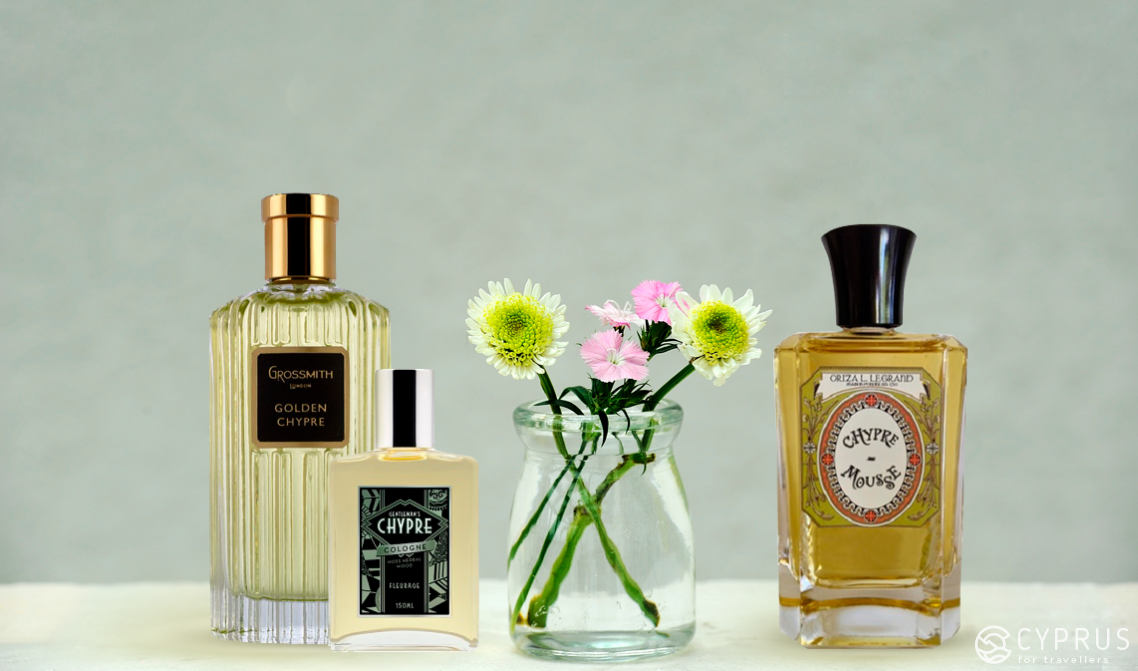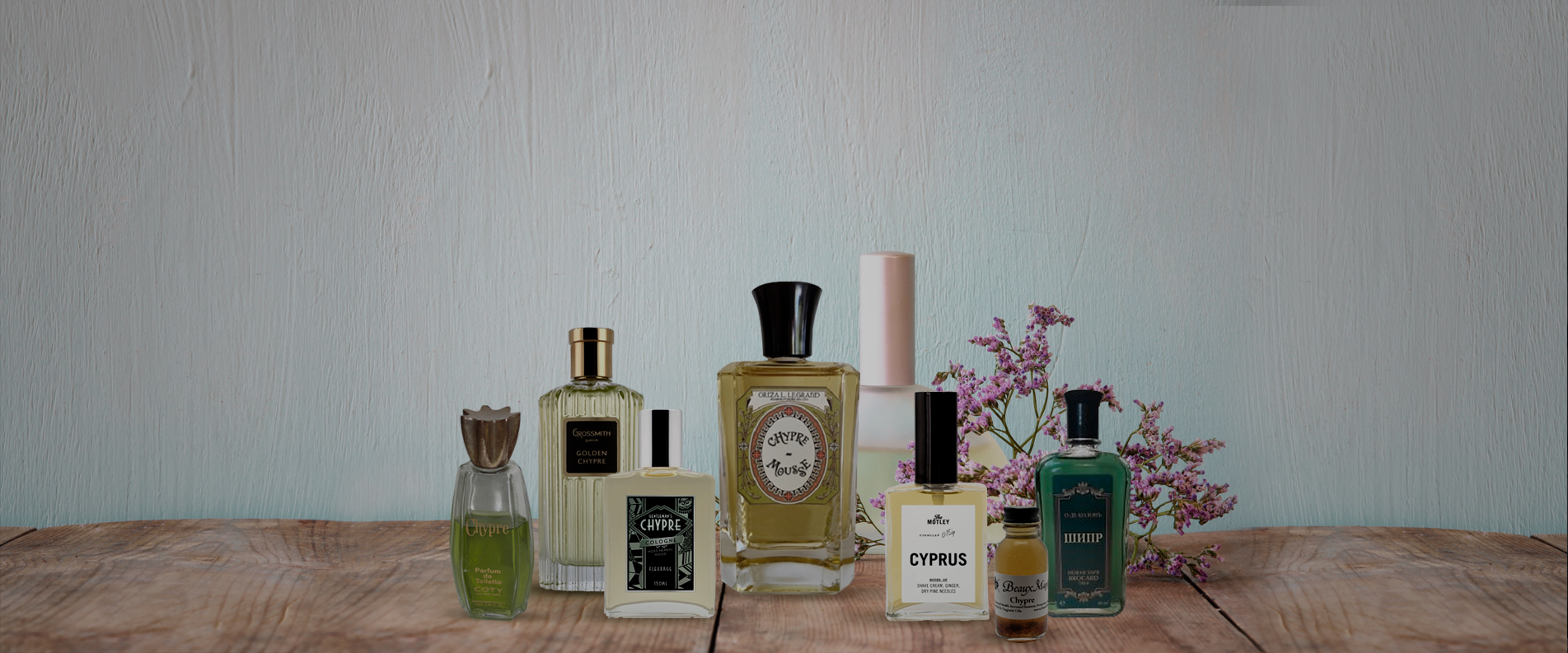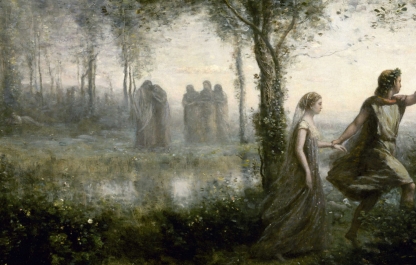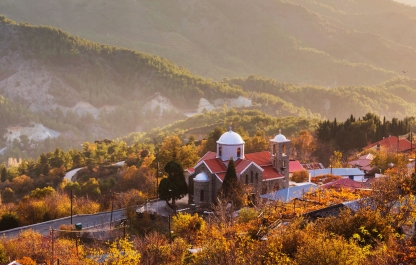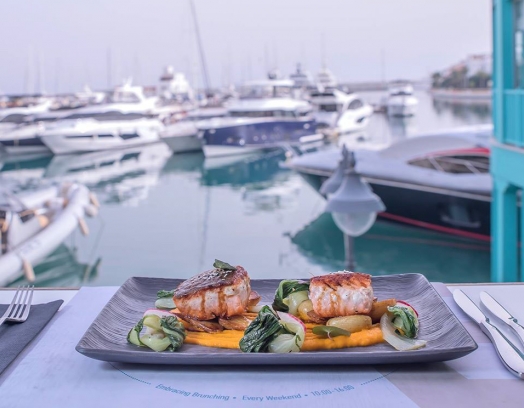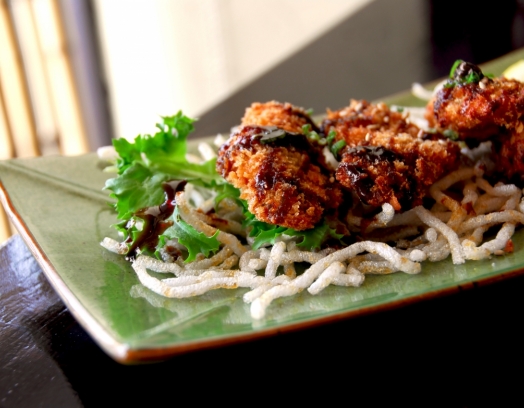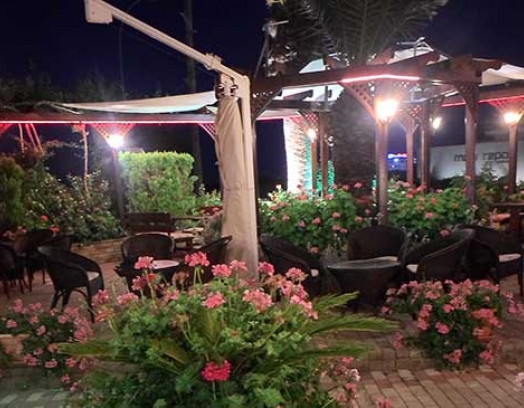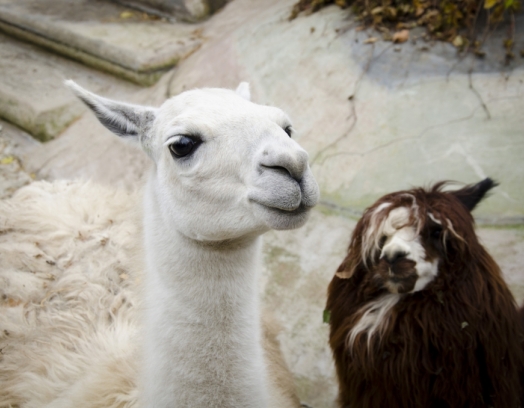It was once believed that Arabic culture of the 7th century gave us the perfume we now enjoy in our everyday life: that touch of beauty and pleasure we savour when we surround ourselves with pleasant scents. Many of us also tend to attach special importance to certain fragrances and keep a keen eye on the latest fashions and trends.
However, new information has shed light on the industry’s origins: the use of essential oils and aromatic compounds is an ancient art. It has been posited that Ancient Egypt is the birthplace of perfume. However, the exquisite-sounding word perfume itself comes from Latin (per fumum — meaning «through smoke» because scented plants were burned to honour the gods in ancient Roman temples (as was in many ancient cultures) with the most common choice being juniper as most pleasing to the deities.
However, there was a surprise in store for the experts as it was recently discovered that it was worth looking a little closer at Cyprus’ history.
In this article, we’ll explore the ancient techniques and methods, reveal which perfume was the favourite among the ancient Cypriots; and find out whether this Cypriot tradition continues to have a presence on the island today.
-
We all know that perfumes, eau de toilette, eau de parfum, colognes, etc — all types of modern perfume contain natural or artificial aromatic substances. Most commonly, they are liquid alcohol-based solutions (ethanol), mixtures of alcohol and water, as well as dipropylene glycol and other liquids, and oils (coconut, jojoba). Perfume is a key part of a range of cosmetics: soaps, gels, creams, shampoos...
Currently, custom has it that perfumes for men and women have different concentrations and vary in terms of the longevity and intensity of the scent. Women's perfumes more commonly contain Eau Dr Parfum (EdP) and Perfume extract. In men's, it's the opposite: here you'll find Eau de Cologne (EdC concentrations), which carry and express lighter scents more clearly.
Very recently, historians found evidence that confirms Cyprus as the birthplace of perfume.
Those of a romantic persuasion,the poetic souls among us are sure that Cyprus is the home of perfume thanks to more than just its abundance of aromatic plants and particular climatic conditions. There's no doubt that the people of Cyprus were inspired by the presence of the goddess of love and beauty herself, Aphrodite and thus had the idea of treating and beautifying themselves with fine perfumes.
Let’s find out more about its history
In 2005, the discovery of the century was made! In the outskirts of Pyrgos, near Limassol, Italian archaeologists found evidence of an ancient perfume production site where the village of Pyrgos Mavromichali stood.
Perfumes dating back over 4000 years were discovered in Cyprus!
The excavation site of the ancient factory spanned one square kilometre. This means that perfume was produced here on an industrial scale and there was a well-established market for it. The finds once again confirmed what had already been asserted: Cypriot perfumes and other aromatic products were clearly in high demand over a long period and extensive trade with foreign countries took place for centuries.
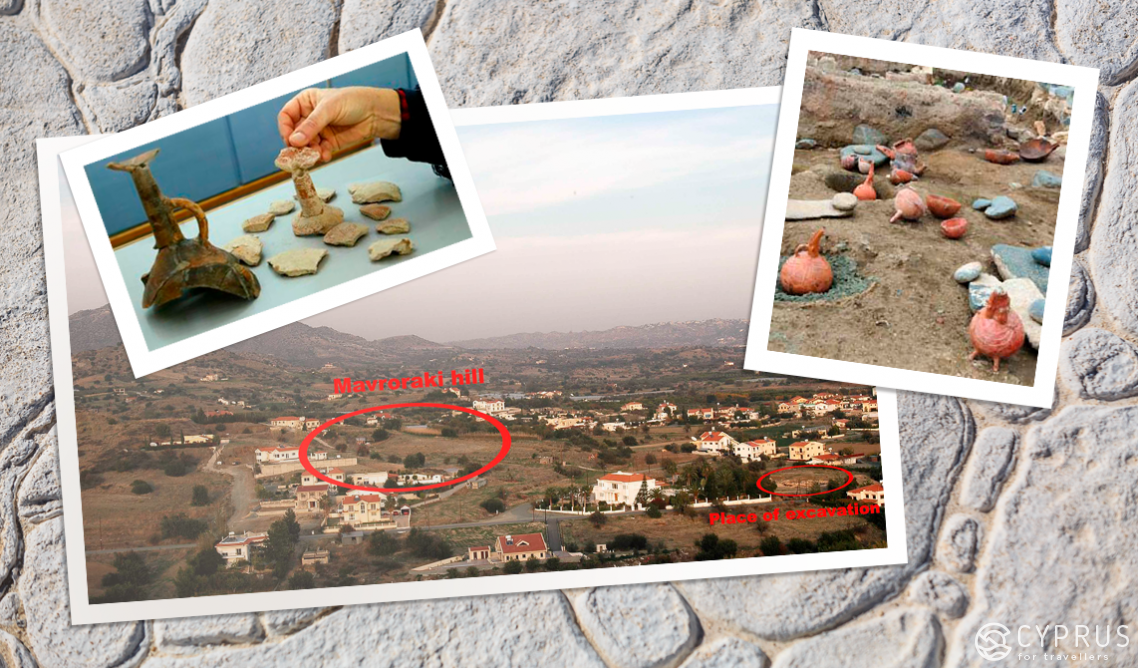
For example, 70 mortars and a few dozen pestles were found in among the ruins of the factory buildings. They were used to grind and mix ingredients used to make the perfume. Several preserved bottles and small earthenware vessels were also found, as well as shards of jugs, which had been broken and buried under the collapsed walls of the buildings after the severe earthquake in 1850 BC. Two whole distillation stills were found too.
The discovered layout of the building was identified as a former laboratory and factory floor.
This meant that the team of Italian historians started to reexamine the history of how and when the ancient Cypriot art of extracting essences and perfume production came about and began to develop. Ultimately, they decided it had started around 2000 BC bringing it in line with the ages of the discovered ruins.
Following the discovery of the factory, a more in-depth investigation by the Technological Institute for the Study of Cultural Heritage under the Italian National Council of Scientific Research started in earnest and is still underway today.
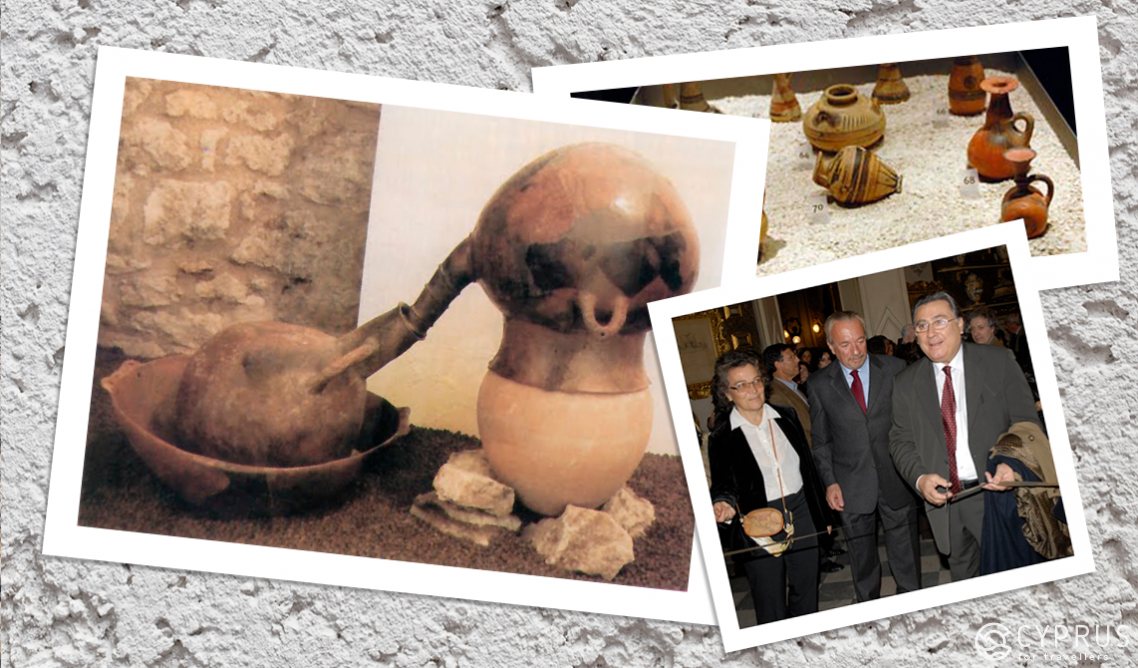
Analysis of the excavated area showed that Cyprus was making perfumes based on essential oils extracted from plants that grow on Troodos in that period.
Essential oils have been used by humankind for millenia. They are volatile, oil-like liquids produced by plants that have strong physiological and pharmacological properties. They are characterised by the plants they were extracted from: lavender, rose, eucalyptus, sandalwood, etc.
Ancient sources cite traditional Cypriot essential oils used in aromatics as: pine and cedar, cinnamon, laurel, myrtle, anise and bergamot.
The historians were able to pin down that there were 12 aromatic substances (extracts) used by ancient Cypriots to make perfumes 4000 years ago. The main production method was distillation, a way of extracting essential oils that’s still used today alongside cold pressing, dissolution or enfleurage (extracting the oils using beef tallow) and extraction using solvents.
It goes without saying that wine played an important role in the creation of the Pyrgos perfumes. In fact, despite the widespread use of chemicals, wine has held on to its important place over the centuries right up to the present day.
It’s no surprise that the archaeologists found more than just evidence of perfume production at the factory site: wine, medicines, bronze wares, and textiles were also made there.
The remains of perfumes found in Pyrgos were scented with extracts of lavender, rosemary, pine or coriander and were stored in small, translucent alabaster vials.
Cypriot perfumes, which are mentioned in the works of many ancient writers, can be found in Egyptian sources as well as the Bible. The main references are made to Sausympkinon, Myrtinum and Amarikinon. Later sources show that the range of Cypriot perfumes were lumped under the umbrella term, Ciprininum.
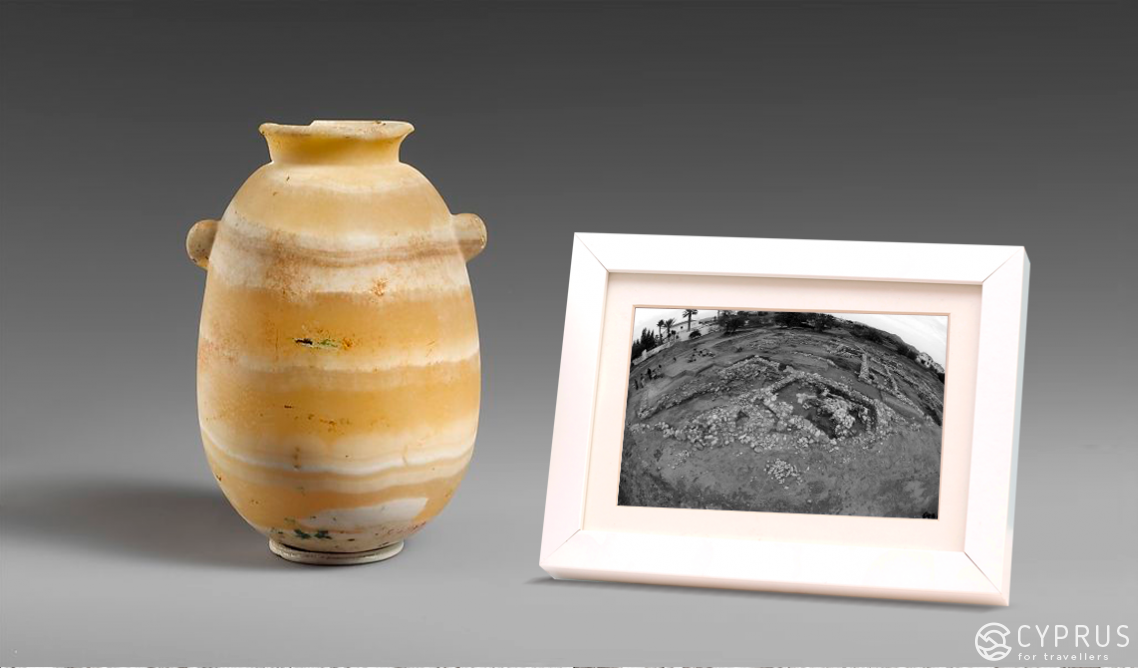
They were renowned throughout the ancient Mediterranean world and Egypt (despite having their own perfume industry, they were not able to produce as much as in Cyprus). Recipes using imported ingredients have been discovered in surviving hieroglyphic texts.
Historians point out that this finding means we can confidently state that Cyprus was a well-established perfume producer which provides a fresh look at the known finds in the tombs of Ancient Egypt, which were placed there as personal belongings of the deceased.
It's also fascinating to consider that perfumes and scents were sacred considered holy in Egypt. That's why the production and trade of the finished product was undertaken under the supervision of priests and thus turned into a symbol and source of their power in earthly society.
It is also curious that in the same Egypt fragrances were sacred and had a divine «status», and therefore, of course, their production and distribution of the «finished product» was under the care of the priests, becoming the next embodiment of their symbol of power on earth.
They were of course used for beauty and therapeutic reasons but were also widely used in religious ceremonies.
In fact, perfumes and cosmetics made from plant-based extracts were accessible to everyone regardless of social standing, wealth, or age. This was confirmed by analysis of female clothing in tombs.
Therefore, these recent discoveries made it possible for modern historians to confirm their ideas that had previously only been based on ancient Egyptian and other ancient sources.
We now had direct information about the production methods, and the types of products and plants used to extract aromatic oils for the first time. Plus, new previously unknown information about the tools used in the workshops, and the storage and transportation containers was revealed. Basically, a lot was uncovered about the various stages of production and the scope of use of the finished perfumes.
A lot of these industries were linked to some extent to the successful mass production of olive oil in the factory alongside that of perfume. The oil was stored in large vessels, which were found extensively across the factory floor of the excavated site.
-
What's more, Cypriot perfumes are mentioned in Greek and Roman works by writers such as Homer, Theophrastus, Pedanius Dioscorídes, and Pliny the Elder.
For example, Homer, the legendary ancient poet the wandering bard (7th century BC) also writes about Aphrodite «graciously visiting her temple with a fragrant altar» where she «ascended and reclined at the shining gates, and three graces anointed her with heavenly oil, divinely sweet, whose fragrance filled her body».
Pliny the Elder, the ancient Roman writer and philosopher (24-79 AD) wrote in his «Natural History», the largest encyclopedic work of antiquity, that «the pleasure gained from perfume is one of the most elegant and honorable pleasures in life».
Pliny also wrote that all the ancient Mediterranean gods tended to be more in favour of mortals and their requests when incense was burned for them during religious ceremonies. However, the biggest perfume fan of all was Aphrodite, the goddess and «native» of Cyprus.
Virgil, one of the greatest and most famous Ancient Roman poets (70-19 BC) also mentions Aphrodite: «the curls of her hair smelled of a heavenly (ambrosia-like) scent»; he states that the Athenians describe her as «clothed in robes saturated with rich treasures of all seasons».
-
In the centuries that followed there were not so many references to the Cyprus perfume industry. However, the island never stopped producing fragrances for personal and religious use despite the endless shifts in power, upheavals, and natural disasters. The continued perfume production over the centuries right up to recent years can be confirmed both by historical sources and preserved items that originate from Old Europe. For example, the famous Cipria bottles and capsules from one of the most famous old cosmetics brands in the world in production since the 15th century.
What’s more, Leonardo da Vinci (1452-1519) once visited the coast of Cyprus (in 1481) and described it thus:
«From the southern seaboard of Cicilia may be seen to the south the beautiful island of Cyprus which was the realm of the goddess Venus, and many there have been who, impelled by her loveliness, have had their ships and rigging broken upon the rocks that lie among the seething waves. Here the beauty of some pleasant hills invites the wandering mariners to take there ease among its flowery verdure, where the zephyrs continually come and go, filling with sweet odours the island and the encompassing sea...».
-
In the 16th century the Italian artisans that made leather gloves moved to the town of Grasse in France. The fashion in Italy at the time involved infusing gloves with fragrant substances to give them a pleasant smell ... which spread these new tastes throughout France. Later, they started producing the raw materials for perfumes in Grasse and today it is the most famous and leading cities in the beauty and fashion industry where the most refined, elite French perfumes are made making it the birthplace of the European perfume fashion.
-
Over time, a lot of perfumes’ names changed or were simply lost as the centuries rolled by. However, Cypriot perfumes continued to be revered.
The three famous Cypriot fragrances, Cyprinum, Amarakos and Amarikinon, mentioned earlier also survived the changes and continued to be produced to the same recipe, maintaining their fans both in the Middle Ages, the Renaissance, the Modern Era, right up to the early 20th century, when Francois Coty (1874-1934), one of the largest perfumers in the world, created the fragrance, Chypre de Coty, in 1917 and dedicated it to the island of Love. This perfume went on to serve as the basis for a whole «family of fragrances» as one of seven (previously 10).
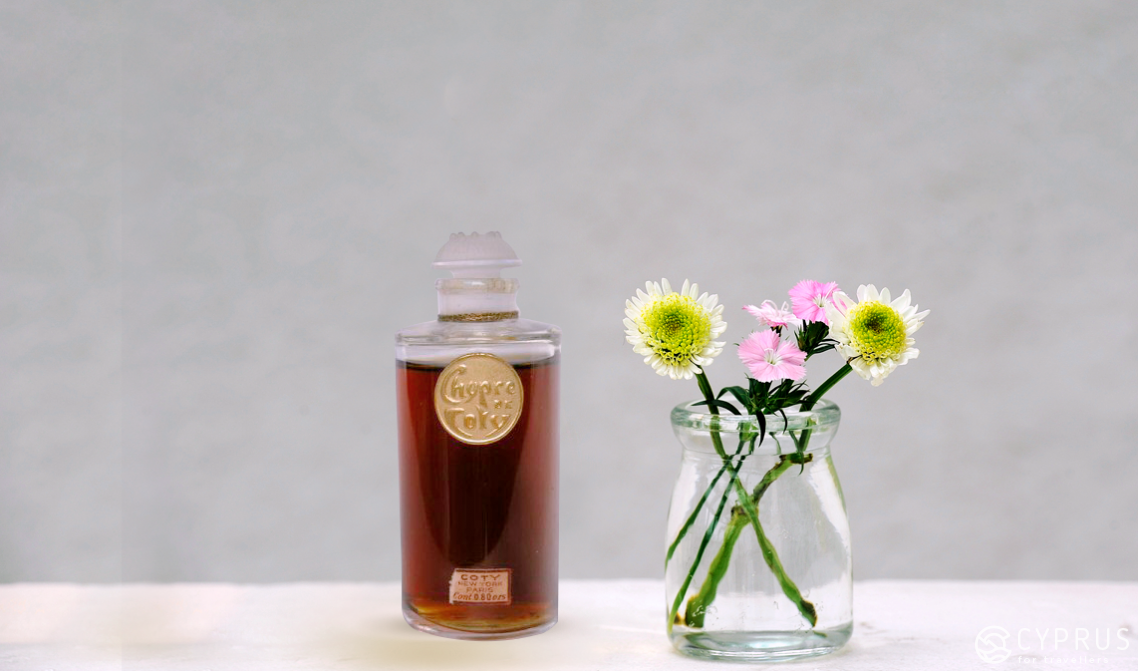
«Chypre» (from the French for Cyprus) are a classic range of perfumes based on a blend of scents: bergamot, oakmoss, patchouli, frankincense, and sandal. The main ingredient of the blend was moss, which grows on oaks in Cyprus.
While they all share a common base, Chypre perfumes differ from each other in their composition and ratios of the given ingredients. In his lifetime, Coty created over 130 scents. Some of them, including Chypre of course, went on to be ranked in the top scents of the 20th century and still enjoy popularity to this day.
In past years, Chypre used to be the number one worldwide best-seller. Today, Chypre accounts for 60% of the most common perfumes.
This «family» is produced by the perfume brand, Fragonard, which is the very heart of modern perfumery. It is on the Cote d'Azur in the aforementioned town of Grasse, France, with its 400-year history of manufacturing perfume. It is one of the oldest perfume producers and stemmed from the factory set up by perfumer Claude Motte created in 1841. The brand was founded in 1926 by former Parisian notary, Eugene Fuchs. Fragonard opened its first Parisian boutique in 1936 on rue Scribe, 9 after the successful release of two scents. It was this brand that started to designate the seven Chypre scents: traditional Chypre, floral, fruity, leather tones, fresh-citric, aromatic, and green.
It wasn't long ago that famous world perfume and fashion houses would buy the original Fragonard recipes and go on to produce and sell mass-produced perfumes under their brand using them as a base.
There's a free museum with displays of rarities that illustrates the development of the perfume industry worldwide.
In more recent history, the USSR released a perfume called Chypre made by the Novaya Zarya factory which was a copy of the Chypre Coty brand.
But back to Cyprus ... to the scents in hand
Later, a book was written using the findings made in Pyrgos and further studies conducted by Ms. Maria Rosaria Belgiorno, a member of the National Research Council (CNR), who headed the expedition and conducted the work. It was called «The Perfume of Cyprus: from Pyrgos to François Coty the route of a legendary charm» (2011).
This work contains a modern interdisciplinary approach and offers their results as part of an innovative model for social development. The aim being to recreate elements of ancient Cypriot civilization and make use of and strengthen the continuity of ancient perfume traditions for today’s community.
Artefacts from Pyrgos Mavromichali are currently on display in in the Capitoline Museum in Rome, along with modern replicas of centuries-old fragrances.
As usual, they encountered pitfalls and difficulties: despite the fact that the meaning and availability of specific ingredients were never in doubt, the exact combination of the proportions and the production process of the most ancient Cypriot perfumes are still unknown.
Belgiorno’s team analysed the remains of perfumes found in jugs and bottles. It discovered that the most common extracts used as a component in ancient perfumes were anise, pine, coriander, bergamot and almonds. What’s more, they are often used in combination with parsley. The scent of the extract itself is quite overbearing and repellant but it makes for a pleasant and lasting aroma when mixed with others.
Ancient fragrances were recreated by the Experimental Archaeological Centre in the town of Blera (Italy) based on four «recipes» found in Pyrgos. They were called Afrodite, Elena, Artemide and Era.
Modern perfumers were also able to create perfumes with the traditional ingredients used in ancient Cyprus as described in recipes in the works of Pliny the Elder and Dioscorídes.
The Italian Consiglio Nazionale delle Ricerche, which set out to recreate ancient traditions in modern conditions, has conducted experiments to obtain finished products identical the ancient ones by following the method described by Pliny: grind aromatic herbs and other essential oil bearing plants, add oil and water to the mixture, then seal them and store them in long-necked vessels over hot coals for 12 hours.
Mavrorachi: this perfume was released in a limited quantity of special decorative bottles by the company, Officina Profumo Farmaceutica di Santa Maria Novella, specially for the exhibition of Pyrgos perfumes in the Museum in Florence. In 2008, they released this perfume for sale.
Pyrgos, the fragrance created by Enrico Buccella, was also released in a decorative bottle for the brand Sigilli in 2010;
Mystiko, created by Yiannoula Lazarou, for Cyprus Herbs Ltd. uses the essential oils of plants of Cyprus in its composition. The fragrance was presented at exhibitions in Pyrgos in 2009, 2010 and 2011 organised by the Pierides Foundation, the Department of Antiquities of the Republic of Cyprus and the Italian organization CNR.
As we can see, the studies of the origin and history of the development of this fragrant family was the reason behind its revival. This Italian-Cypriot cooperation aimed at preserving the cultural heritage of Cyprus.
These perfumes are truly unique and it cannot be be overemphasised. They will clearly have their niche, and inspire the minds and imagination of both perfume connoisseurs as well as history buffs, and those who love looking into Cyprus’ cultural past.
For example, journalists interviewed visitors to the exhibitions and found that the modern-day public actually really like the «fragrances from the past» appreciating their rich and interesting overall scent with a strong and clear woody notes (pine).
In truth, not everyone said they’d be willing to wear them every day.
Even the bottle design was developed modern designers and put into production using methods inspired by Antiquity.
Proceeds from the sale of the perfumes were put towards financing further archaeological work and additional research and experiments with recipes.
In general, perfume experts are unanimous in their opinion when it comes to ancient perfume recipes «we don’t exactly know for sure how perfect and refined the art of making fragrances and producing perfumes used to be but using natural ingredients to infuse your body with pleasant scents, or creating a pleasant perfumed atmosphere at home, or exploiting the medicinal properties of essential oils are all long standing traditions that have been in place since ancient times».
-
The discoveries made by the Italian archaeologists and their research made jointly with their Cypriot colleagues was widely positively received and excited a lot of people ... in Cyprus as well as overseas.
Ten years after the discovery made by the Italians in Pyrgos Mavromichali, an enterprising American perfume and cosmetics company called The Motley from the west coast of the USA launched a new eau de cologne for men called Cyprus.
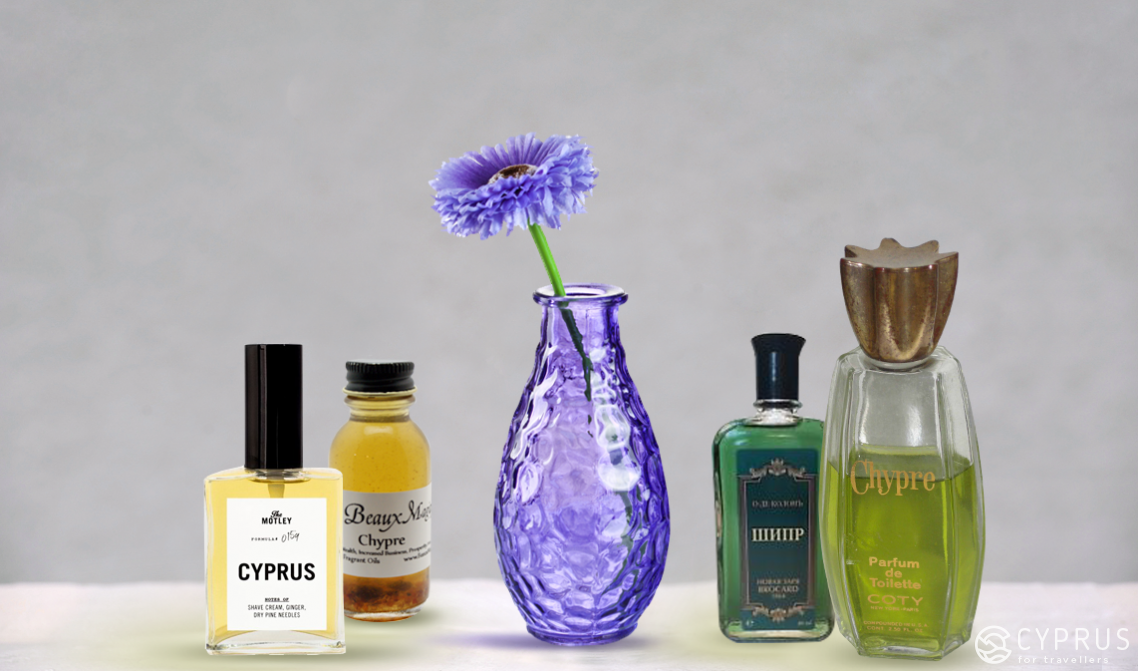
The company’s website states that Cyprus brings to mind the crisp green scent of a coastal forest, the faint smell of saltwater mingling with woody conifers. It also says its cologne’s crisp and clear notes suit young businessmen who have high ambitions and aim for great achievements and career growth.
So what can you find in Cyprus?
Despite the fact that there are almost no large-scale perfume and cosmetic manufacturing companies on the island, there are still companies using traditional recipes to create essential oils for household or religious purposes by extracting the perfumed oils from lemon, lavender, neroli and roses.
There are small (by modern standards) local manufacturers of natural cosmetics that are not so well known abroad. They produce in small batches (often to order) and basically aim at serving the tourists who want to buy natural, fragrant souvenirs. Cypriot cosmetics are made using natural ingredients: lemon peel and neroli, honey and beeswax, white musk, rose water and, of course, rose and olive oil.
The most famous Cypriot brand, VENUS ROSE COSMETICS, makes cosmetics based on rose extract.
The village of Agros, which has its industry in the foothills of Troodos, has been famous for more than 70 years: the Tsolakis family produces various cosmetics from Damask Rose, a variety with an incredible scent. They make creams, emulsions, lotions, shampoos, masks, teas ... and even rose toothpaste. The average cost is somewhere between 5-40 euros.
The village is famous for its rose water and impressive damask roses fields.
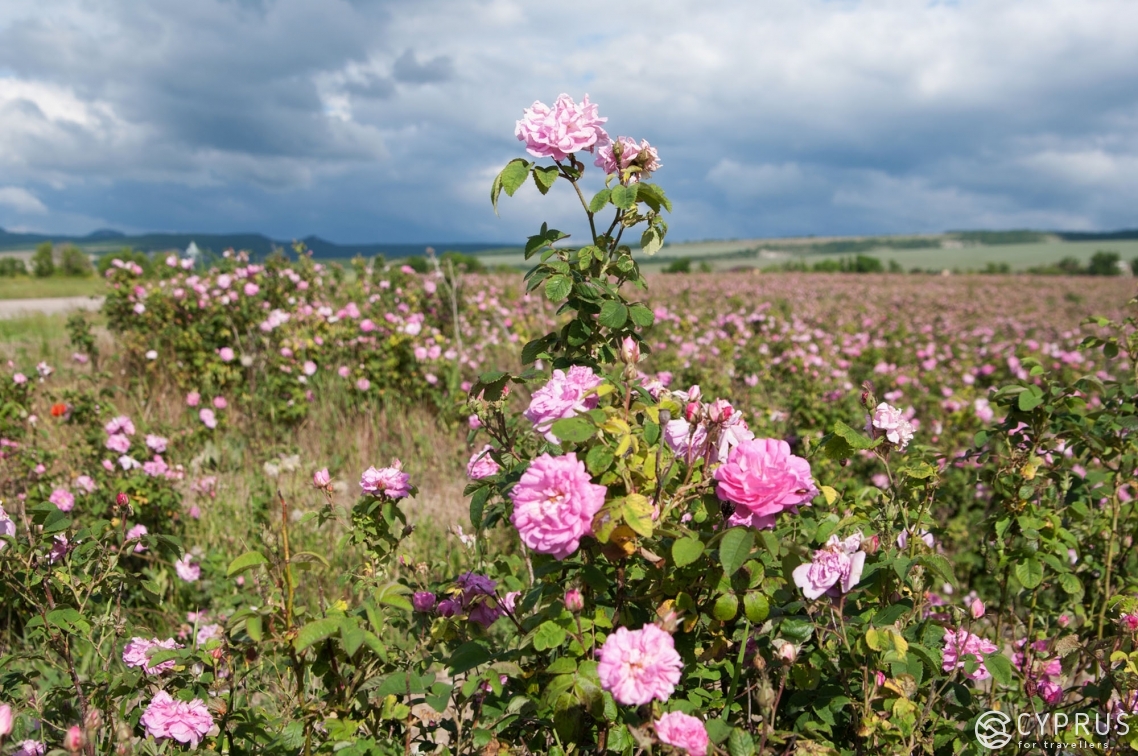
You can visit the famous factory in the village of Argo and see how the local rose petals are transformed into their fragrant cosmetics. After the tour, you’ll find a boutique where you can buy soap, cream, lotions, scrubs, shower gels or perfumes.
Address: Chris N.Tsolakis LTD, 12 Triantafillon str., Agros (Limassol district)
Telephone: +357 25521893
Email: info@venus-rose.com
Another famous place for organic cosmetics connoisseurs on the look-out for products made to traditional recipes, is the botanical garden CyHerbia, which is a botanical garden, pharmacy, and nature park in the village of Avgorou.
The shop sells its own organic products (handmade cosmetics and soap, various teas based on plant extracts and blends). It also has a tea room overlooking the gardens, where you can relax with a cup of a relaxing healing herbal drink.
You can also pop into the distillation room in the neighborhood where you watch the process of extracting essential oil.
Opening hours: daily 9.00 - 19.00 (summer: May 1st until October 31st); daily 9.00 - 17.00 (winter: November 1st - April 30th).
Admission: €5 (adults), €3 (children aged 5-12), children under 5 go free.
Telephone: +357 99915443
Email: cyherbia@gmail.com
The ticket price includes a complimentary cup of herbal tea.
You can buy natural cosmetics and beauty products made with olive oil almost anywhere: there are plenty of tourist and specialist shops to choose from. Do make sure you check out expiry dates before you buy: most natural creams have a shorter lifespan and will keep for about a year and a half.
It's best to keep these cosmetics in the fridge.
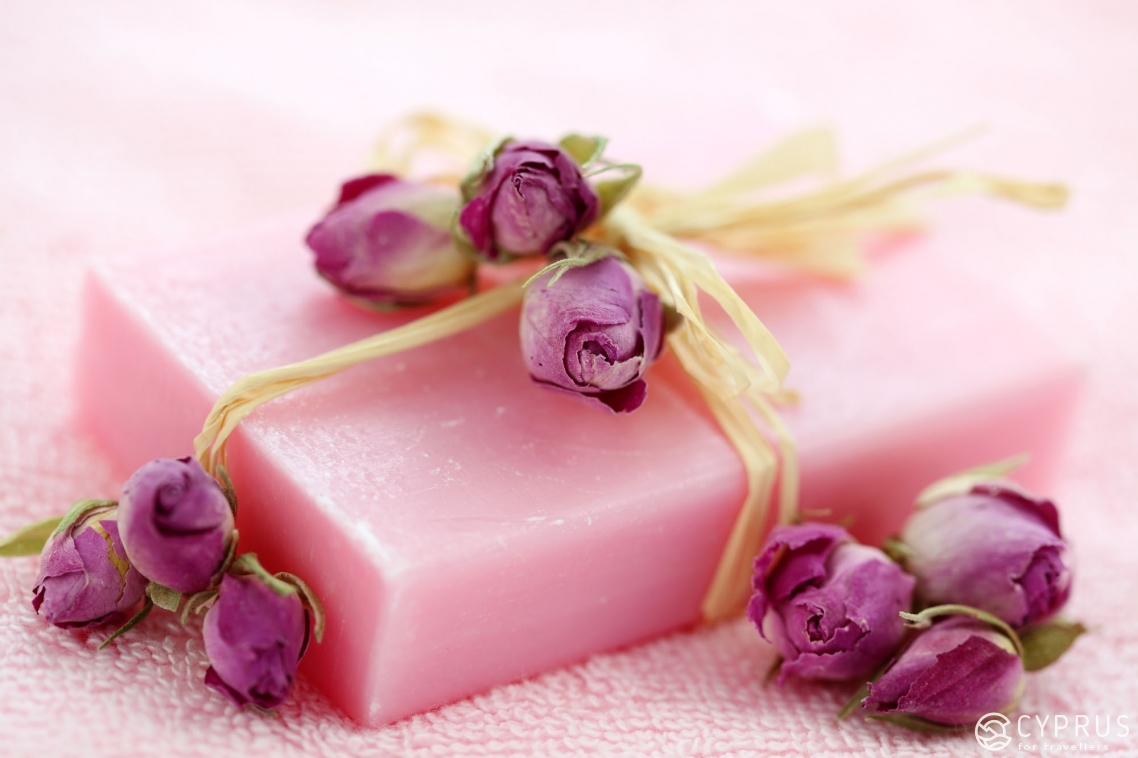
Did you know? There are a few farms in Cyprus that have been producing a range of organic ingredients for major international cosmetics companies.
Famous Cypriot and Greek natural cosmetics brands: Korres, Fresh Line, Afrodita и Apivita. You'll find these ranges in many souvenir and cosmetics shops as well as pharmacies across Cyprus.
There is a pretty wide selection: you can find various natural creams, lotions, tonics, and scrubs made my local individual cosmetics producers as well as cleansing, nourishing, and moisturising masks.
These days, local cosmetics cost somewhere between 2.50 to 10-15 euros.
-
The top places to go beauty and cosmetics shopping in Cyprus are the major cities: Nicosia and Limassol. The tourist areas here and in other Cypriot cities are where you’ll find natural cosmetics in pharmacies, souvenir shops and on the shelves of regular supermarkets. It’s easy to find genuine products almost everywhere. Nevertheless, it’s worth looking further afield too: wander through quieter streets, visit villages, talk to the locals and visit the places they know and love. That way you can discover something new and chances are you’ll save some money too all the while buying high-quality cosmetics and perfumes all based on natural ingredients: olive oil, and extracts of roses, neroli, lavender ...
You can find more information about the various exclusive perfumes made in Cyprus here.
